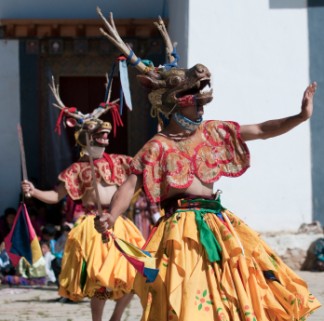
 (Departure November)
(Departure November)
Colorful festivals are very much part of life in Bhutan and the festivities held to celebrate the annual return of the black-necked cranes to the Phobjikha Valley from their summer breeding grounds high on the Tibetan plateau are ones not to be missed. Held annually on November 12, this “welcome” festival for the black necked cranes has traditional masked dances, music and singing paying homage to the migratory cranes who. See Paro,Thimphu, Punakha before Phobjikha and Bumthang. Hike to Tigers’s Nest, located on a steep cliff. Black Necked Crane Festival w/ Bumthang is filled with culture and adventure.
Day 1 – Paro
Arrive Paro where you will be met by our representative and greeted with the traditional Bhutanese Tashi Kadar and Tea.
You are driven to your hotel.
In the afternoon, explore the fortress of Rinpung Dzong, dating from 1645, and walk to the Ta Dzong, a huge mediaeval watchtower which now houses the National Museum of Bhutan.
Day 2 – Paro/Thimphu
Drive to Thimphu, the capital of Bhutan, and check in to your hotel. Visit Changangkha Lhakang and the National Memorial Chorten. Changangkha Lhakhang. was constructed in the 15th century and is one of the oldest temples in the Thimphu Valley. It is dedicated to Avalokiteshvara, the Buddhist emanation of compassion. The temple affords wonderful views over the entire valley. An evening visit to the the National Memorial Chorten offers a good chance to see the locals and their prayer service.
Day 3 – Thimphu/Punakha
After breakfast visit Tango monastery and Cheri Monastery. Tango Monastery is near Cheri Mountain and was founded in the 13th century and later rebuilt in 1688. This monastery is built in the dzong fashion (a fortress like Tibetan architecture), and has a curved (semi-circular) outside wall and prominent main tower. According to religious history, the place which Cheri Monastery rests on was the first place visited by Guru Padmasambhava , the great Buddhist teacher, in the 8th century and is considered sacred ground. Cheri Monastery was built in 1620.) Afternoon drive on to Punakha, the former capital of Bhutan, and check into your hotel.
Day 4 – Punakha/Wangdue/Phobjikha Valley
See Punakha Dzong, majestically standing on an island between the confluence of the Pho Chhu and Mo Chhu rivers, which is one of the most photogenic of all Bhutan’s ancient fortresses Visit the recently restored Gangteng Monastery with its extensive murals depicting the Thousand Buddhas before departing for a brief visit in Wangdue. Drive onward to Phobjikha Valley and check into your hotel.
Day 5 – Phobjikha Valley (Festival)
Your morning is filled with Black Necked Crane Festival activities including folk and masked dances and archery contests along with food and game stalls. Later in the afternoon, drive into central Bhutan, over the Pele La and down into Tongsa and see the largest dzong in the kingdom, the ancestral home of the Royal family. In the evening, watch the black necked cranes continue their migration from Tibet to the valley.
Day 6 – Phobjikha Valley/Bumthang Valley
Today drive onward to Bumthang through the Black Mountains National Park. This is the best place in Bhutan to see yaks from the road. Continuing on you pass the village of Rukubji surrounded by extensive fields of mustard, potatoes, barley and wheat and keep a watchful eye out for Rhesus Macaques (Brown Monkeys). Visit the Mebartsho or “burning lake”, one of the many sacred Buddhist pilgrimage sites. Overnight Bumthang.
Day 7 – Bumthang Valley
Large fields of buckwheat cover the Bhumthang Valley, so buckwheat noodles and pancakes are a Bumthang specialty. Visit the Ura Valley the highest valley in Bumthang and believed by some to have been the home of the earliest inhabitants of Bhutan giving you an insight into how the central Bhutanese live. The cobbled streets of the traditional village of Ura give a medieval feel. The old women of this region still wear sheepskin shawls on their backs which double as a blanket and cushion.
Day 8 – Bumthang/Wangdue
Start making your way back to Paro via Wangdue where you will overnight. The rest of the day is free to explore as you wish.
Day 9 – Wangdue/Paro
After breakfast, drive leisurely onward to Paro. Once you have checked in to your hotel, you can visit the Vajrayana Art Gallery featuring art by Chimmi Dorje, who incorporates Buddhist themes such as prayer flags and mandala motifs into his abstract art. There’s also photography by his brother. You can also visit the Deki Dem Shop which sells religious items
Day 10 – Paro/Taktsang/Paro
Morning hike up to the Taksang Monastery (Tiger’s nest). The climb up to the view point will take around 3 hours and enjoy the stunning view of the monastery, where Guru Padmasambava is believed to have landed on the back of a Tiger in the 8th century, and meditated for three months. The monastery was later built in this holy place in 1684.
Day 11 – Depart Paro
Transfer to the airport for your departure flight.
Cost $2790, per person, land only
(Small group tour with 3 persons minimum to guarantee departure)






